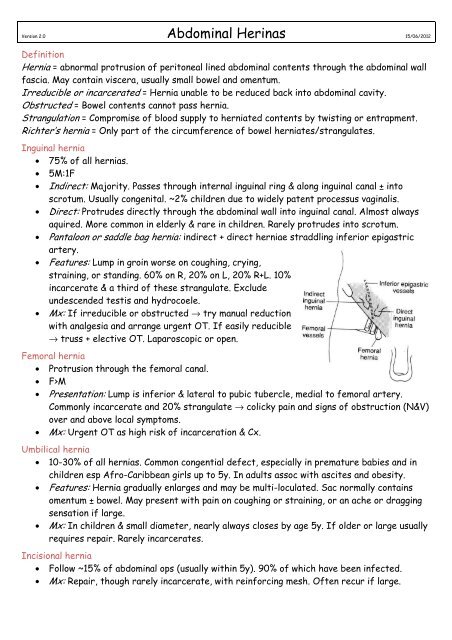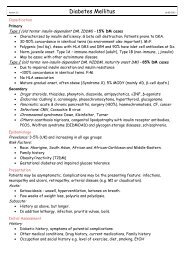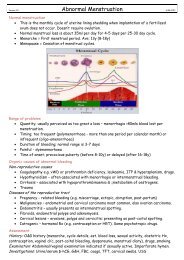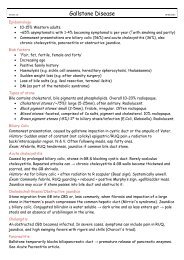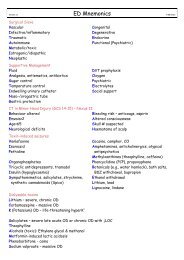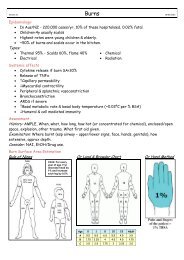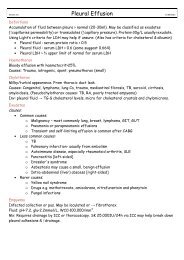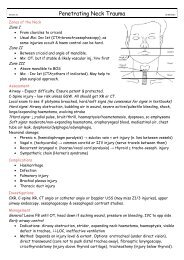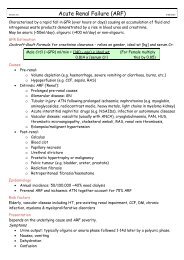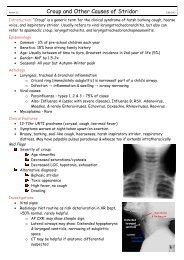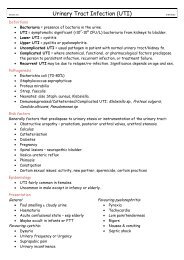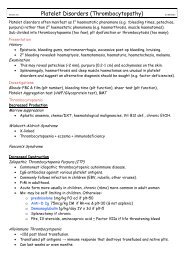Abdominal Wall Hernias
Abdominal Wall Hernias
Abdominal Wall Hernias
- No tags were found...
You also want an ePaper? Increase the reach of your titles
YUMPU automatically turns print PDFs into web optimized ePapers that Google loves.
Version 2.0 <strong>Abdominal</strong> Herinas 15/06/2012DefinitionHernia = abnormal protrusion of peritoneal lined abdominal contents through the abdominal wallfascia. May contain viscera, usually small bowel and omentum.Irreducible or incarcerated = Hernia unable to be reduced back into abdominal cavity.Obstructed = Bowel contents cannot pass hernia.Strangulation = Compromise of blood supply to herniated contents by twisting or entrapment.Richter’s hernia = Only part of the circumference of bowel herniates/strangulates.Inguinal hernia• 75% of all hernias.• 5M:1F• Indirect: Majority. Passes through internal inguinal ring & along inguinal canal ± intoscrotum. Usually congenital. ~2% children due to widely patent processus vaginalis.• Direct: Protrudes directly through the abdominal wall into inguinal canal. Almost alwaysaquired. More common in elderly & rare in children. Rarely protrudes into scrotum.• Pantaloon or saddle bag hernia: indirect + direct herniae straddling inferior epigastricartery.• Features: Lump in groin worse on coughing, crying,straining, or standing. 60% on R, 20% on L, 20% R+L. 10%incarcerate & a third of these strangulate. Excludeundescended testis and hydrocoele.• Mx: If irreducible or obstructed → try manual reductionwith analgesia and arrange urgent OT. If easily reducible→ truss + elective OT. Laparoscopic or open.Femoral hernia• Protrusion through the femoral canal.• F>M• Presentation: Lump is inferior & lateral to pubic tubercle, medial to femoral artery.Commonly incarcerate and 20% strangulate → colicky pain and signs of obstruction (N&V)over and above local symptoms.• Mx: Urgent OT as high risk of incarceration & Cx.Umbilical hernia• 10-30% of all hernias. Common congential defect, especially in premature babies and inchildren esp Afro-Caribbean girls up to 5y. In adults assoc with ascites and obesity.• Features: Hernia gradually enlarges and may be multi-loculated. Sac normally containsomentum ± bowel. May present with pain on coughing or straining, or an ache or draggingsensation if large.• Mx: In children & small diameter, nearly always closes by age 5y. If older or large usuallyrequires repair. Rarely incarcerates.Incisional hernia• Follow ~15% of abdominal ops (usually within 5y). 90% of which have been infected.• Mx: Repair, though rarely incarcerate, with reinforcing mesh. Often recur if large.
Epigastric hernia• Close to midline above the umbilicus.• 3-5% population esp men aged 20-30y.• Multiple herniae in 20%• Features: Usually asymptomatic, but can have epigastric pain ± bloating, N&V post eating.Small hernias may be tender. The hernia can be made to bulge by asking patient to strain.• Mx: Need to be differentiated from a diastasis recti. Surgical repair as high risk ofincarceration or strangulation. 10-20% risk of recurrence after repair.Diaphragmatic hernia• Congenital:o Bochdalek hernia (95%): posterolateral. 85% on left. Paravertebral gas on XR.Usually causes lung hypoplasia & 50% neonatal mortality.o Morgagni hernia (2%): anterior & parasternal. Mostly right sided, containstransverse colon or omentum. Often asymptomatic.o Eventration of diaphragm: Raised thin part of diaphragm allows bulging ofabdominal organs into thoracic cavity.o Congenital hiatus hernia• Hiatus hernia:o Congenital or acquired hernia through hiatus where oesophagus pierces right crusof diaphragm. Acquired assocs:↑age, F>M, obesity, pregnancy, wasting diseases,gallstones.o Types: Sliding hernia (80%): gastroesophageal junction slides up through hiatus. Rolling hernia (10%): Stomach fundus passes up through hiatus Mixed (10%)o Features: GORD, dyspepsia, occ ulcers (sliding) or strangulation/torsion (rolling).o Mx: Inv with endoscopy, Ba swallow/meal. Conservative , anti-GORD Rx,surgery/fundoplication.• TraumaticRarer herniae• Spigelian hernia: Through linea semilunaris muscle. Localised pain → diffuse ache. May bereduced by pressure with a 'gurgling' noise. Needs prompt repair.• Littre's hernia: incls Meckel's diverticulum. 50% inguinal, 20% femoral, 20% umbilical.• Lumbar or dorsal hernia; nearly always in superior & inferior lumbar triangles. Presentswith a lump in the side with a heavy, pulling sensation. Needs surgery.• Obdurator canal hernia: occurs mainly in elderly women with mortality of up to 40%.Presents with symptoms of small bowel obstruction. Usually only palpable on pelvic orrectal examination. Needs urgent repair.• Perineal hernia: usually post perineal surgery and presents with asymptomatic swelling.• Sciatic hernia: very rare, through greater sciatic foramen + incarceration/strangulation.• Sportsman's hernia: debilitating condition which presents as chronic groin pain. A tearoccurs at the external oblique which may result in an occult hernia.• Traumatic hernia: follows blunt trauma and presents with pain, bruising and bulge.


